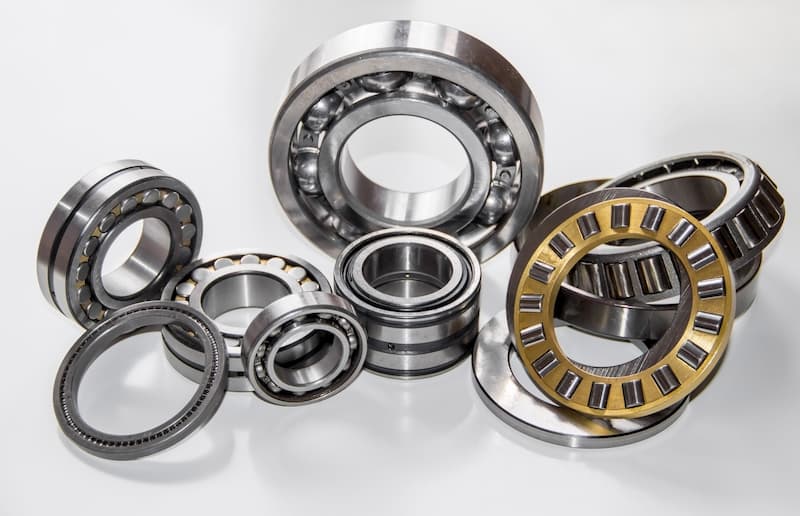From a small supermarket trolley to huge power plants, a great number of light-duty, as well as industrial equipment, could not function without the use of bearings in some form.
Bearings are a crucial tribological component of many types of machinery and exist in a variety of forms and shapes. They can be defined as a machine element that supports/permits only a specific type of motion (restriction of degrees of freedom) in a system that may be under static or dynamic loading.
An example is a sliding door. The door cannot be lifted or removed from its place. It only permits sliding to open it. The possible movement is restricted to sliding motion by bearings.
What Is the Purpose of Bearings?
The main purpose of bearings is to prevent direct metal-to-metal contact between two elements that are in relative motion. This prevents friction, heat generation and ultimately, the wear and tear of parts. It also reduces energy consumption as sliding motion is replaced with low-friction rolling.
They also transmit the load of the rotating element to the housing. This load may be radial, axial, or a combination of both. A bearing also restricts the freedom of movement of moving parts to predefined directions as discussed above.
Rolling Element Bearings
Rolling element bearings contain rolling elements in the shape of balls or cylinders. We know that it is easier to roll a wheel than slide it on the ground as the magnitude of rolling friction is lower than sliding friction. The same principle is in work here. Rolling element bearings are used to facilitate the free movement of parts in rotational motion.
Even when we need linear motion in applications, it is easy to convert rotational motion to sliding motion. Consider an escalator or a conveyor. Even though the motion is linear, it is powered by rollers that are driven by motors.
Another example is a reciprocating pump that can convert rotational energy from a motor into translational motion with the help of linkages. In each of these applications, ball bearings are used to support motor shafts as well as shafts of other rollers in the assembly.
Rolling elements carry the load without much friction as the sliding friction is replaced with rolling friction. Rolling element bearings can be subdivided into two major types: ball bearings and roller bearings.
Ball Bearings
Ball bearings are one of the most common types of bearing classes used. It consists of a row of balls as rolling elements. They are trapped between two annulus-shaped metal pieces. These metal pieces are known as races. The inner race is free to rotate while the outer race is stationary.
Ball bearings provide very low friction during rolling but have limited load-carrying capacity. This is because of the small area of contact between the balls and the races. They can support axial loads in two directions besides radial loads.
Ball bearings are used for controlling oscillatory and rotational motion. For example, in electrical motors where the shaft is free to rotate but the motor housing is not, ball bearings are used to connect the shaft to the motor housing.
Depending on the application, different types of ball bearings are available to choose from.
Advantages of ball bearings:
- Good wear resistance
- Do not need much lubrication
- Provide low friction, thus little energy loss
- Long service life
- Easy to replace
- Small general dimensions
- Comparatively cheap
- Can handle thrust loads
Disadvantages of ball bearings:
- May break due to shocks
- Can be quite loud
- Cannot handle large weights
Deep Groove Ball Bearings
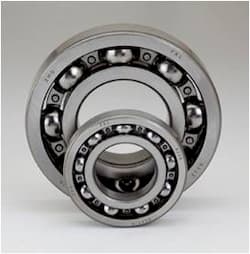
Deep groove ball bearings are the most widely used ball bearing type. Trapped between the two races is a ring of balls that transmit the load and allows rotational motion between the two races. The balls are held in place by a retainer.
They have very low rolling friction and are optimized for low noise and low vibration. This makes them ideal for high-speed applications.
They are comparatively easy to install and require minimal maintenance. Care must be taken during installation to prevent denting of the races as they have to be push fit onto shafts.
- Personal account manager
- Quality assurance
- Payment terms for companies
- On-time delivery by Fractory
Angular Contact Ball Bearings
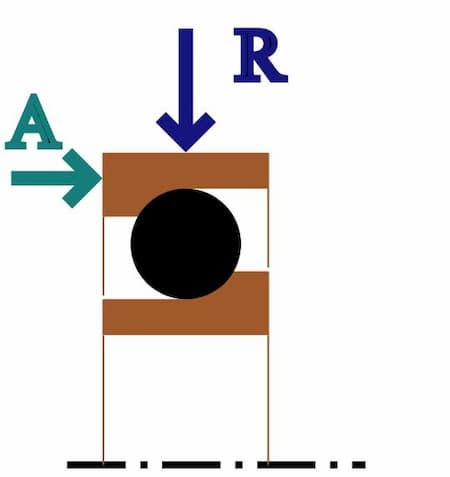
In this ball bearing type, the inner and outer races are displaced with respect to each other along the bearing axis. Angular contact roller bearings are designed to handle greater amounts of axial loads in both directions in addition to radial loads.
Due to the shift in the inner and outer races, the axial load can be transferred through the bearing to the housing. This bearing is suitable for applications where rigid axial guidance is required.
Angular contact bearings are widely used in agricultural equipment, automobiles, gearboxes, pumps, and other high-speed applications, such as CNC machining tool spindles.
Self-Aligning Ball Bearings

This type of ball bearing is immune to misalignment between the shaft and the housing which may happen due to shaft deflection or mounting errors.
The inner ring has deep grooves similar to deep groove ball bearings followed by two rows of balls and the outer ring. The outer ring has a concave shape and this grants the inner ring some freedom to rearrange itself depending on the misalignment.
Thrust Ball Bearings
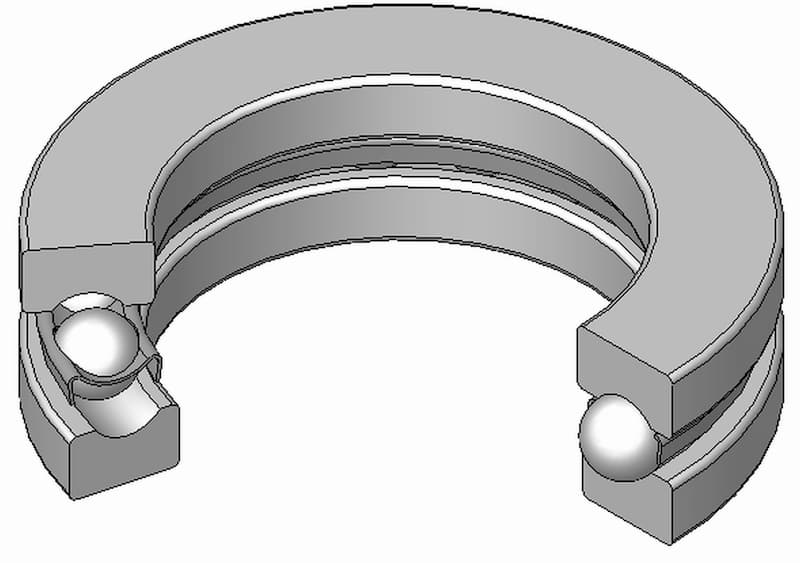
Thrust ball bearings are a special type of ball bearings designed specifically for axial loads. They cannot sustain radial loads at all.
Thrust ball bearings exhibit low noise, smooth operation and are capable of high-speed applications.
They are available as single-direction or double-direction bearings and the selection relies on whether the load is unidirectional or bidirectional.
When to Use Ball Bearings?
So let’s outline some of the working conditions that may require a ball bearing.
- Thrust loads are present. Ball bearings’ design makes them capable of withstanding axial loads.
- No heavy loads. Due to having ball-shaped rolling elements, the bearings concentrate all the force onto a few points of contact. This can result in early failure with high loads.
- High speeds. The ball bearing’s small point of contact also means less friction. So there is less resistance to overcome and thus it is easier to achieve high speeds with these types of bearings.
Roller Bearings
Roller bearings contain cylindrical rolling elements instead of balls as load-carrying elements between the races. An element is considered a roller if its length is longer than its diameter (even if only slightly). Since they are in line contact with the inner and outer races (instead of point contact as in the case of ball bearings), they can support greater loading.
Roller bearings are also available in various types. The appropriate type may be selected after considering the type and magnitude of loading, service conditions, and the possibility of misalignment among other factors.
Advantages of roller bearings:
- Easy maintenance
- Low friction
- Can take high radial loads
- Tapered roller bearings can withstand high axial loads
- Great accuracy
- Used to adjust the axial displacement
- Low vibrations
Disadvantages of roller bearings:
- Noisy
- Quite expensive
Cylindrical Roller Bearings
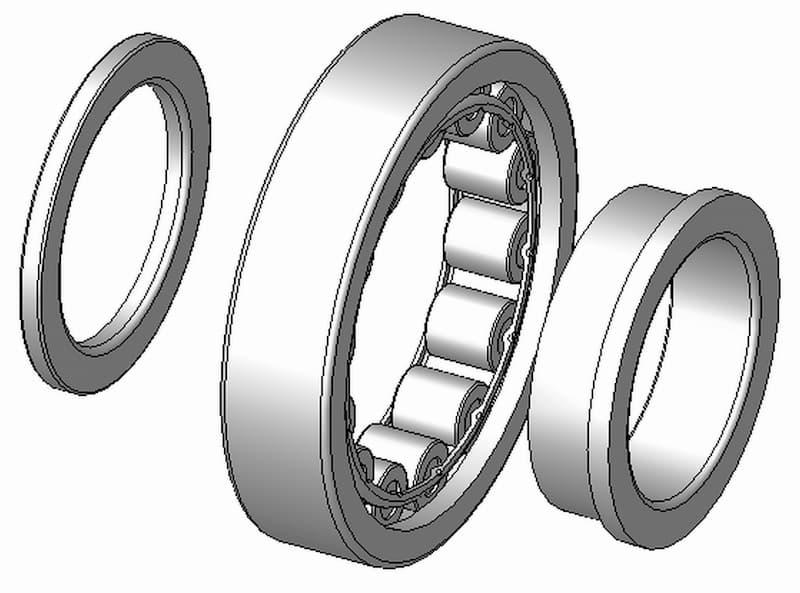
Cylindrical roller bearings are the simplest of the roller bearings family. These bearings can face the challenges of heavy radial loading and high speed. They also offer excellent stiffness, axial load transmission, low friction, and long service duration.
The load capacity can be increased further by obviating the use of cages or retainers that are usually in place to hold the cylindrical rollers. This permits the fitting of more rollers to carry the load.
They are available as single-row, double-row and four-row types. They also come in split and sealed variants.
Split variants are used for areas that are difficult to access such as engine crankshafts. In sealed variants, the bearing contamination is prevented and the lubricant is retained making it a maintenance-free option.
Spherical Roller Bearings
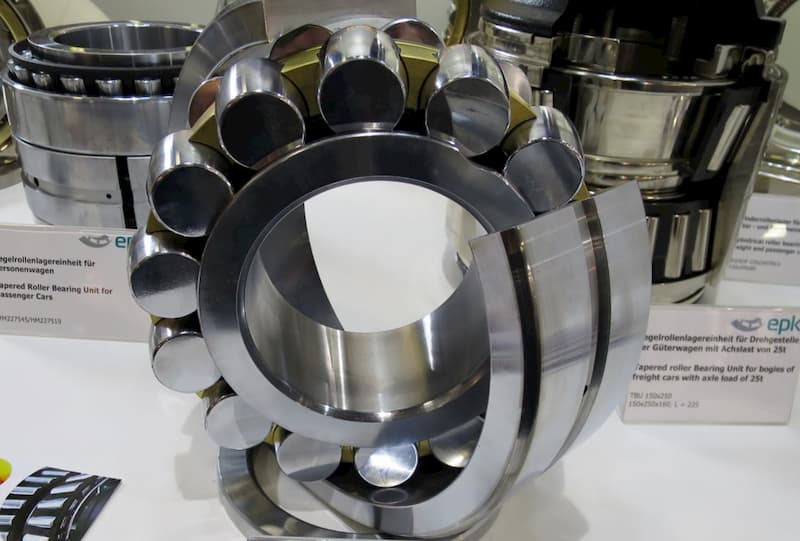
Heavy radial and axial loads can be a greater challenge when the shaft is prone to misalignment.
This situation can be handled very well by spherical roller bearings. Spherical roller bearings have high load-carrying capacities and can manage misalignment between the shaft and housing. This reduces maintenance costs and improves service life.
Spherical roller bearing raceways are inclined at an angle to the bearing axis. Instead of straight sides, the rollers have spherical sides that fit onto the spherical raceways and accommodate small misalignments.
Spherical roller bearings have a wide range of use cases. They are used in applications where heavy loads, moderate to high speeds and possible misalignment occur. Some examples are off-road vehicles, pumps, mechanical fans, marine propulsion, wind turbines, and gearboxes.
Tapered Roller Bearings
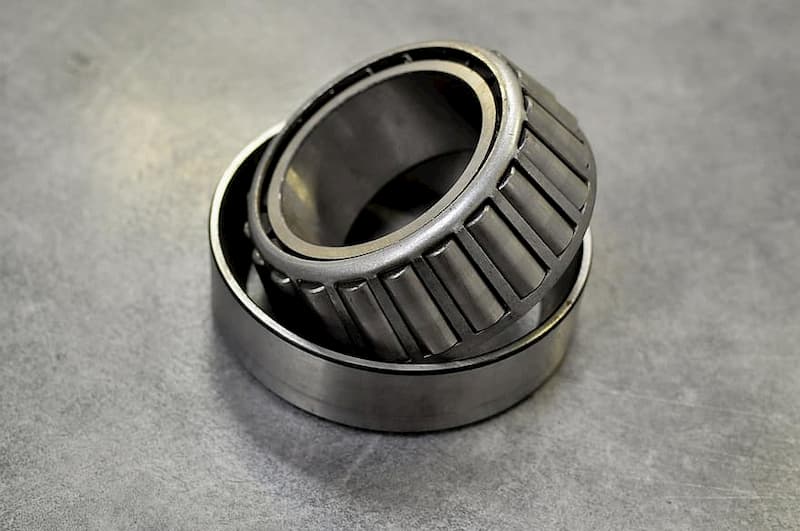
The tapered roller bearing contains sections of a cone as a load-carrying element. These rollers fit between the two races that are also sections of a hollow cone. If the races and the axes of rollers were extended, they would all meet at a common point.
Tapered roller bearings are designed to handle higher axial loads besides radial loads. The larger the half-angle of this common cone, the more axial load it can sustain. Thus they work as thrust bearings as well as radial load bearings.
Tapered roller bearings are used in back-to-back pairs so that axial forces can be supported equally in either direction.
Needle Roller Bearings

Needle roller bearing is a special type of roller bearing that has cylindrical rollers that resemble needles because of their small diameter.
Normally, the length of rollers in roller bearings is only slightly more than its diameter. When it comes to needle bearings, the length of rollers exceeds their diameter by at least four times.
As needle roller bearings have a smaller diameter, more rollers can be fit in the same space which increases the surface area in contact with the races. Thus, they are capable of handling high loads. The small size can also prove helpful in applications where space is limited as they require smaller clearances between the axle and the housing.
Needle bearings are used in automobile components such as transmission and rocker arm pivots. They are also used in compressors and pumps.
Thrust Roller Bearings
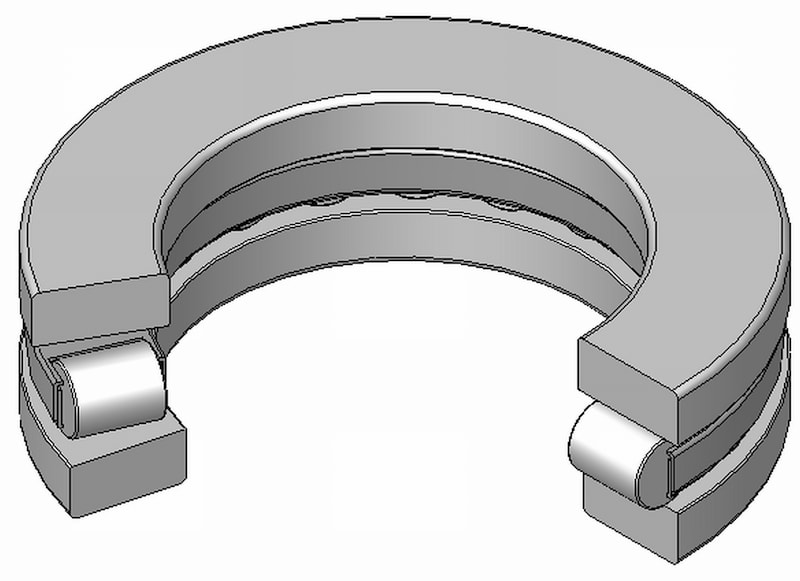
Thrust roller bearings are designed to sustain high axial loads and are available with three types of rollers: cylindrical, tapered and spherical. These bearings offer high axial rigidity and are well-suited for heavy loads.
Cylindrical roller thrust bearings have good axial load-carrying capacity and are relatively cheap. These bearings should be avoided if there are any radial loads present. Compared to thrust ball bearings they tend to wear quicker due to higher friction. They are not suited for high speeds due to the differential sliding of the rollers.
Tapered roller thrust bearings can tolerate slight eccentricity that occurs between the shaft and housing during operation. There is no real difference between tapered roller thrust bearings and tapered roller bearings and the amount of axial loads these bearings can tolerate, alongside radial loads, depends on the half angles of the cones. They can support greater thrust loads than thrust ball bearings due to the larger contact area but are more expensive to manufacture.
Spherical roller thrust bearings are designed to take heavy axial loads in one direction and accommodate some radial loads as well. They are self-aligning and are thus unaffected by mounting errors and shaft deflection.
When to Use Roller Bearings?
Roller bearings are the most common alternative to ball bearings. So let’s determine what kind of working conditions are best suited for this type of bearing.
- Heavy loads. Roller bearings provide a considerably larger area of contact, distributing the load more evenly. Thus, they are less prone to failure and can withstand high forces.
- Lower speeds. This, again, comes down to the contact area. There is more friction which can result in higher temperature generation and quicker wear.
Plain Bearings
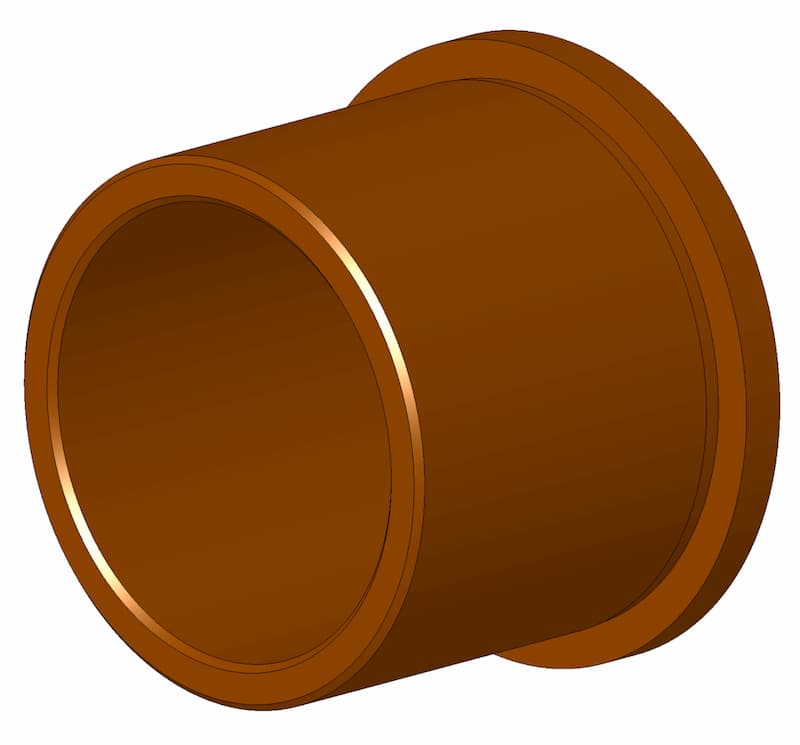
A plain bearing is the simplest type of bearing. It usually only consists of a bearing surface. There are no rolling elements.
The bearing is basically a sleeve mounted on the shaft and it fits into the bore, thus it is sometimes referred to as a sleeve bearing. Plain bearings are inexpensive, compact and lightweight. They have high load-carrying capacity.
Plain bearings are used for rotational, sliding, reciprocating or oscillatory motion. The bearing remains fixed while the journal slides on the bearing’s inner surface. To facilitate smooth movement, material pairs with low coefficients of friction are selected. Different types of copper alloys, for example, are pretty common.
This bearing can accommodate some misalignment, multi-directional movements, and is suitable for static as well as dynamic loads. Plain bearings are used extensively in applications in the agriculture, automotive, marine, and construction industries.
The gudgeon pin that connects the piston to the connecting rod in diesel engines is connected through a plain bearing.

The spherical bearing is also a plain bearing, although it consists of 2 parts – the inner ring and the outer ring. Although it looks similar to ball and roller bearings from the outset, they have no rolling elements between the two rings.
Fluid Bearings
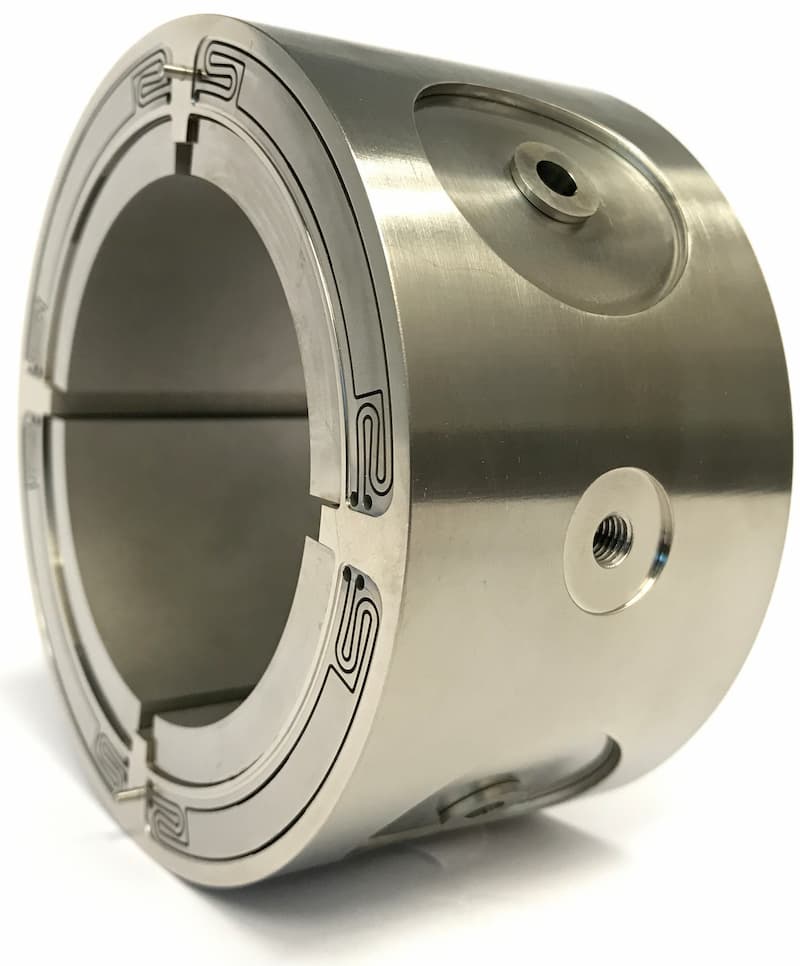
Fluid bearings rely on pressurised gas or liquid to carry the load and eliminate friction. These bearings are used to replace metallic bearings in applications where they would have a short life in addition to high noise and vibration levels.
They are also increasingly being used to cut costs. Fluid bearings are used in machines that work at high speeds and loads. While the initial costs are higher, the longer lifespan in tough conditions makes up for it in the longer run.
When the machine is running, there is zero contact between the two elements (except during the start and stop) and hence it is possible to achieve near zero wear with fluid bearings.
Fluid bearings are classified into two types: hydrostatic and hydrodynamic bearings.
Hydrostatic Bearings
In this type, an externally pressurised fluid is forced between two elements that are in relative motion. The pressurised fluid forms a wedge between the moving parts and keeps them apart. The fluid layer may be very thin but as long as there is no direct contact, there will not be any wear.
The fluid is circulated by means of a pump. The exit orifice diameter may be adjustable to ensure the fluid is always under pressure at all shaft speeds and loads. Thus, precise gap control is possible.
Hydrodynamic Bearings
This type of bearing utilises the motion of the journal to force the fluid between the shaft and the housing. The journal motion sucks the lubricating fluid between the moving parts creating a constant wedge.
This, however, means that during start-stop as well as at low loads and speeds, the wedge formation may not be good enough to prevent wear. Only at designed speeds will the system work exactly as needed.
Magnetic Bearings
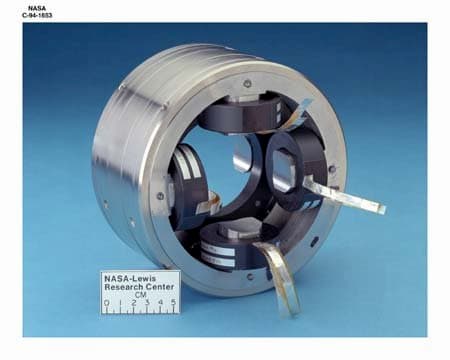
Magnetic bearings use the concept of magnetic levitation to hold the shaft mid-air. As there is no physical contact, magnetic bearings are zero-wear bearings. There is also no limitation on the maximum amount of relative speed it can handle.
Magnetic bearings can also accommodate some irregularities in shaft design as the shaft’s position is automatically adjusted based on its centre of mass. Thus, it may be offset to one side but will still function just as satisfactorily.
They are broadly classified into two types: Active and passive magnetic bearings.
Active Magnetic Bearings
Active magnetic bearings use electromagnets around the shaft to maintain its position. If a change in position is picked up by sensors, the system adjusts the amount of current being fed to the system and returns the rotor to its original position.
Passive Magnetic Bearing
Passive magnetic bearings use permanent magnets to maintain a magnetic field around the shaft. This means there is no power input needed. The system is, however, difficult to design due to limitations as this technology is still in its early stages.
In many cases, the two types of magnetic bearings may be used in tandem where the permanent magnets handle the static loading while the electromagnets are used to maintain the position to a high degree of accuracy.


